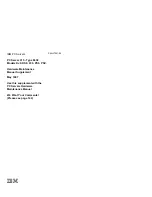
Chapter 5. Solving problems
39
Memory problems
Verify that:
1.
The memory modules are seated properly.
2.
You have installed the correct type of memory.
3.
If you changed the memory, you updated the memory configuration with the
Configuration/Setup Utility program.
4.
All banks of memory on the DIMMs are enabled. The server might have
automatically disabled a DIMM bank if it detected a problem, or a DIMM bank
might have been manually disabled.
If these items are correct, run the memory diagnostic program. The server might have
detected a bad memory module and automatically reallocated memory to enable the
server to continue to operate. If the memory tests fail, call for service or replace the
failing DIMM.
Look in the POST error log for error message 289:
•
If a DIMM was disabled by a system-management interrupt (SMI), replace the
DIMM.
•
If a DIMM was disabled by the user or POST:
1.
Start the Configuration/Setup Utility program.
2.
Enable the DIMM.
3.
Save the configuration and restart the server.
•
If you continue to get this error, replace the DIMM.
If the problem remains, call for service.
The amount of memory
displayed is less than the
amount of memory that is
installed.
Microprocessor problems
The startup (boot) microprocessor is not working properly.
Verify that the startup microprocessor is seated properly. If it is, have the startup
microprocessor replaced.
If the problem remains, call for service.
The server emits a continuous
tone during POST.
Monitor problems
Some IBM monitors have their own self-tests. If you suspect a problem with the
monitor, refer to the information that comes with the monitor for adjusting and testing
instructions.
If you still cannot find the problem, call for service.
Testing the monitor.
The screen is blank.
Verify that:
1.
The server power cords are plugged into the server and a working electrical
outlet.
2.
The monitor cables are connected properly.
3.
The monitor is turned on and the Brightness and Contrast controls are adjusted
correctly.
If the screen remains blank, call for service.
Important: In some memory configurations, the 3-3-3 beep code might sound during
POST followed by a blank display screen. If this occurs and the Boot Fail Count
feature in the Start Options of the Configuration/Setup Utility program is set to
Enabled (its default setting), you must restart the server three times to force the
system BIOS code to reset the CMOS values to the default configuration (memory
connector or bank of connectors enabled).
Only the cursor appears.
Call for service.
Table 2. Troubleshooting charts (continued)
Symptom
Suggested action
Summary of Contents for Eserver xSeries 360 Type 8686
Page 1: ...IBM IBM xSeries 360 Type 8686 Installation Guide...
Page 10: ...x IBM xSeries 360 Type 8686 Installation Guide...
Page 16: ...6 IBM xSeries 360 Type 8686 Installation Guide...
Page 38: ...28 IBM xSeries 360 Type 8686 Installation Guide...
Page 56: ...46 IBM xSeries 360 Type 8686 Installation Guide...
















































